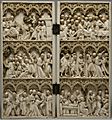Bas-relief facts for kids
Bas-relief is a type of relief (sculpture) that has less depth to the faces and figures than they actually have, when measured proportionately (to scale). This technique keeps the natural shapes of the figures and allows the work to be seen from many angles without twisting the figures themselves.
There is a continuation of the bas-relief technique into the next category, altorilievo, or high relief. High relief makes deeper images than bas-relief. Instead of shallow backgrounds that are a few inches (cm) deep at most, they can be up to several feet (a few meters) deep in altorilievo.
Some of the best examples of bas-relief are the Assyrian Lion Hunt Reliefs, which are housed at the British Museum. The attention to detail and appearance of the lions moving make them stand out, especially for the time period they were made in.
Related pages
Images for kids
-
Side view of Lorenzo Ghiberti's cast gilt-bronze Gates of Paradise at the Florence Baptistery in Florence, Italy, combining high-relief main figures with backgrounds mostly in low relief
-
A face of the high-relief Frieze of Parnassus round the base of the Albert Memorial in London. Most of the heads and many feet are completely undercut, but the torsos are "engaged" with the surface behind
-
Low-relief on Roman sestertius, 238 AD
-
A low-relief dating to circa 2000 BC, from the kingdom of Simurrum, modern Iraq
-
High-relief deities at Khajuraho, India
-
French Gothic diptych, 25 cm (9.8 in) high, with crowded scenes from the Life of Christ, c. 1350–1365
-
Persian low or bas-relief in Persepolis – a symbol of Zoroastrian Nowruz – at the spring equinox the power of the bull (personifying Earth) and lion (personifying the Sun) are equal.
-
Assyrian low relief, Lion Hunt of Ashurbanipal, North Palace, Nineveh
-
Atropos cutting the thread of life. Ancient Greek low relief
-
Donatello, Madonna and Child in rilievo stiacciato or shallow relief














